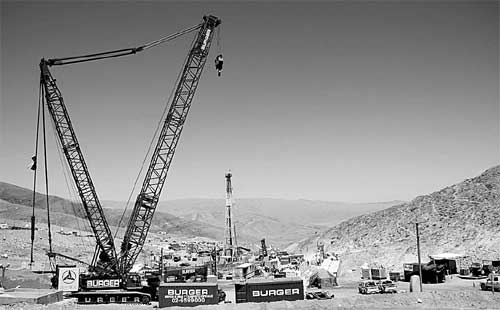Economy
China plays key role in Chile rescue
By Liu Yiyu and Zhou Siyu (China Daily)
Updated: 2010-10-18 08:06
 |
Large Medium Small |
BEIJING - "Made In China" has won a reputation for quality in the international arena after a Chinese-made machine was involved in rehearsals for the dramatic rescue of 33 trapped miners in Chile.
 A SCC4000 Sany crawler crane was on standby at the rescue site where 33 miners were trapped for 69 days in the San Jose Mine, Chile. [Photo provided to China Daily] |
The Chinese crawler crane attracted worldwide attention in the successful recovery of the men stuck 700 meters underground for more than two months in a copper mine in the north of the country.
|
||||
"The fact that we have been chosen over other big names in the industry highlights the recognition of the performance of our products. We had 100 percent confidence in the success of this task," Zhou Fugui, senior vice-president of Sany Heavy Industry Co, said.
Sany's SCC4000 crawler crane participated in several rounds of rescue rehearsal. Although it was not used in the actual rescue because of the geological conditions at the site and a change of plan, industry experts, who had received an emergency summons, praised its stable and reliable performance throughout the rehearsal, Zhang Zhongke, overseas manager of Sany Group, said.
The red-painted independently-designed and manufactured machine was ready at the site throughout the whole rescue process in case of any contingency, Zhang added.
"Local people were encouraged by the presence of our machine, saying 'Chinese machines are very strong'," said Zhang.
Chile bought the crane from Sany in 2008 and it was selected by the Chilean government for the rescue operation on Oct 3 after reviewing its operational record over two years, said Zhou.
 Supporting technician Hao Heng, a service manager with Sany Chile Subsidiary, said the crane had been held in reserve in case a winch used in the rescue failed to perform on Oct 13 when the 33 trapped miners were being brought to safety. [Photo provided to China Daily] |
For Chinese manufacturers such as Sany, it was a great opportunity to prove the reliability and quality of China-made machines.
That the SCC4000 was chosen by the Chile government as a candidate among other international competitors for rescuing the miners showed their trust in China's heavy machinery industry, Sany said on its website.
The same type of machine has been used in several rescue operations in the United Kingdom.
About half of SCC4000 cranes are now sold abroad, with foreign sales expected to grow within the near future, Zhou predicted.
Sany Group produces a variety of heavy cranes ranging up to 1,600 tons in tensile force. The one used in Chile was only 400 tons.
Crawler cranes over 1,000 tons in tensile force are quite popular both at home and abroad.
In China, these large cranes were widely employed in the construction of nuclear stations. Europe, the United States and other developed economies have become increasingly interested in Sany's products, said Zhou.
Sany Group's clout has expanded in the machinery industry globally in recent years. A 60-million yuan research and development (R& D) center was set up in India this year. Another costing $60 million was built in Atlanta, and a third costing 100 million was established in Germany in 2009. They were designed to enhance product quality and meet local demand.
The company, based in Changsha, Hunan province, has pumped more than 2 billion yuan ($294.51 million) into building up manufacturing and R&D bases in the US, India and Brazil since 2007.
Its rival, Changsha Zoomlion Heavy Industry Science and Technology Development Co, is also setting up industry chain bases in South Asia, North America and Europe as Chinese brands develop better reputations abroad.
As one of the largest makers of machinery in the world, Chinese manufacturers are getting more and more recognition in both delivery speed and quality, aside from the traditional advantage in price.
China made machines are generally sold at prices 10 to 20 percent lower than foreign brands while the quality is becoming equivalent, industry analysts said.
Spanish wind equipment manufacturer Gamesa said of Chinese wind turbine manufacturers that they did "not only excel at the speed of delivery but also were competitive in quality".
Realizing the progress made by Chinese competitors, overseas manufacturers are being forced to make "new products at cheaper prices" in order to compete with their Chinese counterparts, said Gamesa Chairman Jorge Calvet.
Meanwhile, China's exports of machinery and electronic products registered a 34.5 percent increase for the first three quarters of this year. As domestic companies get increasingly competitive in the global market, surges are likely to continue, industry insiders said
"The primary reason for the export increase is that Chinese companies are becoming much stronger players in the global market. They not only boast advantages in terms of advanced techniques, but are also starting to earn worldwide recognition for their outstanding quality," said Liu Chun, secretary-general of the China Chamber of Commerce for Import and Export of Machinery and Electronic Products.



